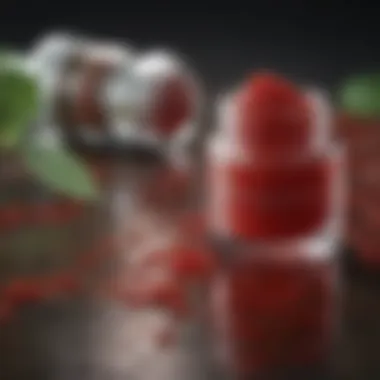Discover Effective Ways to Eliminate Red Acne Scars and Achieve Clearer Skin


Beauty Tips and Tricks
When it comes to addressing red acne scars effectively, incorporating a well-rounded skincare routine is paramount. Begin by cleansing your face with a gentle yet effective cleanser to remove impurities and excess oil. Follow up with exfoliation using a suitable scrub to slough off dead skin cells and promote cell turnover, helping to fade the appearance of red acne scars over time. Incorporating a targeted serum containing ingredients like vitamin C or niacinamide can aid in brightening skin tone and reducing inflammation associated with acne scars. Finally, don't forget to moisturize daily to maintain skin hydration and barrier function, crucial for overall skin health.
Moving beyond skincare, consider consulting with a dermatologist or skincare specialist for professional treatments that can expedite the fading of red acne scars. Options such as chemical peels, microdermabrasion, or laser therapy can significantly improve the appearance of acne scars by promoting collagen production and skin regeneration. These treatments should be performed by qualified professionals to ensure safety and efficacy, providing lasting results in achieving smoother, clearer skin.
Understanding Red Acne Scars
Understanding red acne scars is crucial for anyone looking to improve their skin's appearance and target specific skincare concerns effectively. By delving into the causes and types of red acne scars, individuals can tailor their treatment plans to address these issues accurately. This section provides a foundation for readers to grasp the underlying factors contributing to red acne scars, paving the way for informed decision-making in their skincare journey.
Causes of Red Acne Scars
Inflammation and Post-Inflammatory Hyperpigmentation
Inflammation and post-inflammatory hyperpigmentation play pivotal roles in the formation of red acne scars. The inflammatory response triggered by acne breakouts leads to increased melanin production, resulting in the characteristic red or dark marks left behind. Understanding this process is essential as it influences the choice of treatment options for addressing red acne scars effectively. While inflammation is a natural response to skin damage, excessive or prolonged inflammation can exacerbate scarring, emphasizing the need to manage it promptly.
Picking or Squeezing Pimples
Picking or squeezing pimples can worsen inflammation and damage the skin's protective barrier, leading to heightened redness and scarring. This common habit can introduce bacteria deeper into the skin, increasing the risk of infection and subsequent scarring. By highlighting the detrimental effects of picking at acne lesions, individuals can cultivate better skincare practices to prevent the exacerbation of red acne scars and promote overall skin health.
Genetics and Skin Type
Genetics and skin type influence an individual's predisposition to developing red acne scars. Certain genetic factors can impact how the skin responds to inflammation and heals from acne breakouts, potentially increasing the likelihood of scarring. Additionally, varying skin types exhibit unique characteristics that affect scar formation and resolution. Understanding these genetic and skin-specific aspects is essential for tailoring skincare routines and treatments to address red acne scars effectively.
Types of Red Acne Scars
Erythematous Scars


Erythematous scars, characterized by red or pink discoloration, signify persistent inflammation in the affected areas. These scars often result from vascular dilation and increased blood flow to the skin during the healing process. By recognizing the distinctive appearance of erythematous scars, individuals can differentiate them from other types of acne scars and choose appropriate treatments to reduce redness and promote skin recovery.
Macular Scars
Macular scars present as flat, red marks that differ from other raised or depressed scar types. These superficial scars typically fade over time but may linger if not addressed promptly. Understanding the transient nature of macular scars and their responsiveness to specific treatments is essential for devising targeted skincare routines to expedite scar fading and restore skin clarity.
PIE (Post-Inflammatory Erythema) vs. PIH (Post-Inflammatory Hyperpigmentation)
Distinguishing between post-inflammatory erythema (PIE) and post-inflammatory hyperpigmentation (PIH) is crucial for accurate diagnosis and treatment of red acne scars. While PIE manifests as red or purplish marks indicative of vascular changes, PIH appears as darkened spots due to excess melanin production. By understanding these distinctions, individuals can select suitable interventions to address the specific characteristics of PIE and PIH, promoting effective scar reduction and skin renewal.
Home Remedies for Red Acne Scars
In the realm of skin healing, home remedies for red acne scars play a crucial role in addressing these pesky marks left behind by acne breakouts. More than just cost-effective alternatives to professional treatments, home remedies offer natural solutions that can be gentle on the skin. By incorporating these remedies into your skincare routine, you empower yourself with effective tools for scar reduction and skin rejuvenation. Understanding the benefits and considerations of home remedies for red acne scars is essential in unlocking their full potential. These remedies not only target the scars themselves but also promote overall skin health and radiance. Embracing natural ingredients can be a rewarding journey towards clearer, more vibrant skin.
Natural Ingredients for Scar Healing
Aloe Vera
Aloe Vera stands as a powerhouse ingredient in scar healing, renowned for its soothing and anti-inflammatory properties. This natural gel derived from the Aloe plant is packed with vitamins, enzymes, and antioxidants that nourish the skin and promote healing. Its cooling sensation helps reduce redness and calm irritated skin, making it a popular choice for treating red acne scars. Aloe Vera's hydrating qualities also aid in improving skin texture and tone, enhancing the overall appearance of scars. While Aloe Vera is gentle and generally well-tolerated, some individuals may experience allergic reactions, necessitating a patch test before extensive use.
Honey and Cinnamon
The combination of honey and cinnamon presents a potent blend for scar healing and skin rejuvenation. Honey, with its antibacterial and wound-healing properties, helps promote tissue regeneration and reduce inflammation. Cinnamon, on the other hand, boasts antibacterial and anti-inflammatory effects that can aid in fading red acne scars. Together, these ingredients create a synergistic effect that can help brighten the skin, improve scars' appearance, and enhance overall skin health. It is important to note that while these ingredients offer numerous benefits, individuals with sensitive skin or allergies should exercise caution and perform a patch test prior to use.
Rosehip Seed Oil
Renowned for its high concentration of essential fatty acids and antioxidants, Rosehip Seed Oil emerges as a valuable asset in scar healing. This cold-pressed oil aids in skin regeneration, helping to fade red acne scars and improve skin texture. Rich in vitamins A and C, it promotes collagen production and skin hydration, leading to a more even complexion. The lightweight nature of Rosehip Seed Oil allows for easy absorption, making it suitable for all skin types. While Rosehip Seed Oil is generally well-tolerated, it is advisable to conduct a patch test to ensure compatibility and assess any potential allergic reactions.


Skincare Products for Red Acne Scars
In the realm of skincare, products designed explicitly for red acne scars play a pivotal role in the journey towards achieving clearer, smoother skin. These specialized formulations are crafted to target the specific issues associated with red acne scars, such as hyperpigmentation and uneven skin tone. By understanding the ingredients and benefits of these products, individuals can make informed choices to address their skin concerns effectively and efficiently. Skincare products tailored for red acne scars offer a holistic approach to scar management, combining nourishing elements with targeted treatments to promote skin healing and renewal.
Topical Treatments
Vitamin Serums
Vitamin C serums are a cornerstone in scar management, known for their potent antioxidant properties and collagen-boosting effects. These serums work to brighten the skin, fade pigmentation, and promote overall skin health. By incorporating vitamin C serums into a skincare routine, individuals can enhance the skin's natural healing processes, leading to a more even complexion and reduced appearance of red acne scars. However, it is essential to note that vitamin C serums may cause irritation for sensitive skin types, so conducting a patch test is recommended before regular use.
Retinol Creams
Retinol creams are celebrated for their skin-renewing properties, aiding in cell turnover and collagen production. By incorporating retinol into a skincare regimen, individuals can target acne scars, improve skin texture, and promote a youthful glow. Retinol creams offer a powerful solution for those seeking to diminish the appearance of red acne scars, although they may cause sensitivity to sunlight, necessitating the usage of sunscreen during the day.
Niacinamide Products
Niacinamide products are revered for their versatility in skincare, known for their ability to reduce inflammation, regulate sebum production, and improve skin barrier function. Incorporating products rich in niacinamide can help fade red acne scars, enhance skin resilience, and address various skin concerns. Niacinamide products are suitable for all skin types, making them a popular choice for individuals looking to tackle acne scars without risking irritation or adverse reactions.
Scar Healing Gels and Creams
Silicone Gel Sheets
Silicone gel sheets are a clinically-proven method for scar management, renowned for their ability to flatten scars, maintain hydration, and protect the skin barrier. By applying silicone gel sheets to red acne scars, individuals can minimize the appearance of scars over time, leading to smoother, rejuvenated skin. While silicone gel sheets demonstrate efficacy in scar healing, prolonged use may cause skin irritation in some individuals, necessitating moderation and careful monitoring.
Allium Cepa Gel
Allium cepa gel, derived from onions, contains quercetin and sulfur compounds that aid in scar reduction and skin regeneration. Known for its anti-inflammatory and antioxidant properties, allium cepa gel is a gentle yet effective solution for diminishing red acne scars and promoting skin healing. Individuals sensitive to onion extracts should perform a patch test before using allium cepa gel regularly to prevent any adverse reactions.


Green Tea Extract Creams
Green tea extract creams harness the antioxidant power of green tea polyphenols to soothe inflammation, protect against UV damage, and promote skin rejuvenation. By incorporating green tea extract creams into a skincare routine, individuals can combat redness, improve skin texture, and reduce the appearance of acne scars. While green tea extract creams offer multiple benefits for scar healing, individuals with caffeine sensitivities should exercise caution and consult a dermatologist before use.
Professional Treatments for Red Acne Scars
In the realm of treating red acne scars, professional treatments play a crucial role in achieving desired results. Professional treatments offer advanced solutions beyond what home remedies or skincare products can provide. These procedures are typically performed in dermatologist offices or skincare clinics by trained professionals with expertise in skin treatments. They are tailored to address specific types of acne scars and can significantly improve the appearance of the skin. Professionals combine their knowledge with specialized equipment to deliver effective outcomes.
Dermatological Procedures
Dermatological procedures encompass a range of treatments designed to target red acne scars at a deeper level. These procedures are known for their efficacy in addressing various types of scars and promoting skin regeneration. The following subsections delve into specific dermatological procedures that are commonly utilized for treating red acne scars:
Chemical Peels
Chemical peels involve the application of a chemical solution to the skin, which causes exfoliation and peeling. This process helps to remove damaged skin cells, stimulate collagen production, and improve skin texture. Chemical peels are beneficial for reducing the appearance of red acne scars by promoting cell turnover and revealing fresher skin. Their customizable nature allows dermatologists to adjust the strength of the peel based on individual skin concerns, making them a versatile option for scar treatment.
Microdermabrasion
Microdermabrasion is a non-invasive procedure that uses a diamond-tipped wand or crystals to exfoliate the skin gently. By removing the outer layer of dead skin cells, microdermabrasion enhances skin rejuvenation and promotes the growth of new skin cells. This treatment is effective in reducing redness and improving skin tone, making it a popular choice for addressing red acne scars. Microdermabrasion is suitable for various skin types and requires minimal downtime, making it a convenient option for individuals seeking scar reduction.
Laser Therapy
Laser therapy involves the use of focused light energy to target specific areas of the skin affected by acne scars. This treatment helps to stimulate collagen production, reduce redness, and enhance skin elasticity. Laser therapy offers precise results and can be customized to address individual scar types. It is a popular choice for its ability to deliver significant improvements in skin texture and tone. While laser therapy may require multiple sessions for optimal results, many individuals find it to be a highly effective solution for red acne scars.
Lifestyle Changes and Preventive Measures
In the grand scheme of combatting red acne scars, lifestyle changes and preventive measures play a pivotal role. These elements are the unsung heroes in the quest for clear and flawless skin. By incorporating specific habits into your daily routine, you can not only address existing acne scars but also prevent new ones from forming. Lifestyle modifications encompass a range of practices that bolster skin health from within, ensuring a holistic approach to skincare. From diet choices to daily rituals, every decision can influence the way your skin looks and feels. Therefore, paying close attention to lifestyle factors is paramount in the journey towards vibrant and blemish-free skin.
Daily Skincare Habits
- Sun Protection: One crucial aspect of daily skincare habits is sun protection. Shielding your skin from harmful UV rays can significantly reduce the risk of exacerbating red acne scars. Sun protection not only prevents further pigmentation but also safeguards the skin's overall health and youthfulness. Opting for a broad-spectrum sunscreen with a high SPF rating is a wise choice, as it offers maximum defense against UVB and UVA rays. Consistent application of sunscreen, especially when exposed to sunlight, ensures that your skin remains shielded from potential damage, contributing to a more even skin tone and texture.
- Gentle Cleansing: Gentle cleansing stands out as a cornerstone in daily skincare habits. Using mild, non-abrasive cleansers helps to rid the skin of impurities without stripping away its natural oils. Gentle cleansing preserves the skin's delicate balance, preventing irritation and inflammation that can worsen acne scars. Opt for products free from harsh chemicals and fragrances, focusing on nurturing and soothing ingredients that pamper the skin while maintaining its integrity.
- Moisturizing: Moisturizing is a fundamental aspect of daily skincare that should not be overlooked. Hydrating the skin with a suitable moisturizer not only helps to maintain its moisture levels but also fortifies its natural barrier function. Moisturizing is essential for all skin types, including oily and acne-prone skin, as it prevents dehydration and aids in the regeneration of damaged skin cells. Choosing a lightweight, non-comedogenic moisturizer ensures that your skin receives the nourishment it needs without clogging pores or exacerbating acne scars.
Dietary Considerations
- Antioxidant-Rich Foods: Incorporating antioxidant-rich foods into your diet is a game-changer when it comes to improving skin health. Antioxidants combat free radicals that can lead to skin damage, including the formation of acne scars. Fruits, vegetables, nuts, and seeds abundant in vitamins C and E, beta-carotene, and selenium provide your skin with the nutrients it needs to repair and rejuvenate, promoting a clear and glowing complexion.
- Hydration: Staying adequately hydrated is a simple yet powerful dietary consideration for skin health. Drinking ample water throughout the day helps to flush out toxins from the body, keeping skin cells plump and vibrant. Proper hydration supports the skin's natural functions, aiding in the healing of acne scars and maintaining overall skin elasticity and radiance.
- Omega-3 Fatty Acids: Omega-3 fatty acids are essential fats that offer a plethora of benefits for skin health. From reducing inflammation to promoting skin repair, incorporating omega-3-rich foods like fatty fish, flaxseeds, and walnuts into your diet can work wonders for acne scars. These healthy fats support the skin's natural barrier, ensuring adequate moisture retention and suppleness, leading to a smoother and more even skin texture.







